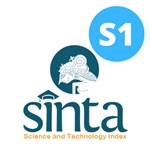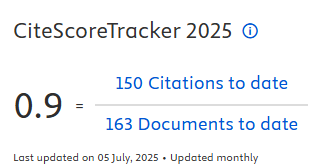Mapping Analysis of Personal Protective Equipment Usage as an Effort to Reach Zero Accident at Ponorogo Hospital
Downloads
Introduction: One of the efforts to reduce the risk of occupational accident and occupational diseases is awareness regarding the importance of the safety and health of workers in hospitals, which is also a top priority in hospitals during a pandemic situation. The application of health protocols and the use of Personal Protective Equipment (PPE) are the main lines of defense against the risk of disease and occupational accident. So that the use of Personal Protective Equipment (PPE) is very important, especially for workers during a pandemic. The purpose of this study was to analyze the mapping of the use of Personal Protective Equipment (PPE) with the incidence of occupational accident. Methods: The research used was an analytic observational type using a cross sectional approach, besides that the researchers conducted a survey of the conditions in the hospital. With a sample of 179 respondents in all parts of the hospital. Results: There is an effect of the use of PPE on the incidence of work accidents and it is necessary to have a mapping of PPE, such as gloves, safety shoes, surgical glasses, surgical gown, apron, mask, face shield, head protection, safety helmet, safety shoes, body harness, fire-resistant clothing, fire-resistant helmet, fire-resistant goggles, and fire-resistant gloves. Conclusion: Control is needed in the form of procurement of Personal Protective Equipment at Hospital X, including face shields, aprons, gloves, masks, head protectors, and safety shoes.
Arbianti, K. and Hanirizqy, M. (2019) ‘Hubungan Pengetahuan Dokter Gigi Terhadap Penggunaan Alat Perlindungan Diri (APD) Di Rumah Sakit Islam Gigi Dan Mulut Sultan Agung Semarang', ODONTO : Dental Journal, 6(1), pp. 1-7.
Arif, A. et al. (2021) ‘Physiological Impacts of Personal Protective Equipment on Health Care Workers', The Indonesian Journal of Occupational Safety and Health, 10(1), pp. 1-5.
Arifah, D. A., Rahmah, R. A. A. and Diannita, R. (2021) ‘Anxiety and Sleep Quality among Medical Workers in Harjono S Hospital Anxiety', The 4th International Conference on Health Polytechnics of Surabaya (ICOHPS) 1st International Conference of Nursing and Public Health Science (ICoNPHS), 1(21), pp. 225–230.
Arrosit, A. M. M. (2021) ‘Supervisi Akademik Kepala Sekolah Dalam Meningkatkan Kinerja Guru (Studi Kasus Di Ma Maarif Al-Falah Ngrayun Ponorogo)'. Thesis. Ponorogo: Islamic Educatioan Management Program, Institut Agama Islam Negeri Ponorogo.
Australian Government Department of Health (2020) ‘Guidance on the use of personal protective equipment (PPE) in hospitals during the COVID-19 outbreak', Infection Control Expert Group (ICEG), 6(June), pp. 1–9.
Basri, A. A., Rahma, R. A. A. and Diannita, R. (2020) ‘Relationship of Predisposing and Enabling Factors with Unsafe Action of Nurse in the Inpatient Unit I of Rsud Dr. Saiful Anwar Malang', Indian Journal of Public Health Research & Development, 11(11), pp. 383–388.
Battista, R. A. et al. (2021) ‘Personal Protective Equipment (PPE) in Covid 19 Pandemic: Related Symptoms and Adverse Reactions in Healthcare Workers and General Population', Journal of Occupational and Environmental Medicine, 63(2), pp. 80–85.
Castro-Sánchez, E. et al. (2021) ‘Evaluation of a Personal Protective Equipment Support Programme for Staff during the COVID-19 Pandemic in London', Journal of Hospital Infection, 109 (2021), pp. 68–77.
Diannita, R. (2015) ‘Analisis Penerapan Sistem Informasi Pelayanan Pasien Di Klinik Utama UIN Sunan Kalijaga Health Center', Cakra Buana Kesehatan, I (1), pp. 1–8.
Dwiastuti, Y. R., Suroto, S. and Kurniawan, B. (2015) ‘Evaluasi Manajemen Alat Pelindung Diri (APD)', Jurnal Kesehatan Masyarakat (Undip), 3(3), pp. 651–663.
Food Drug Administration (2021) ‘Personal Protective Equipment for Infection Control', pp. 2–5.
Gunawan, I. and Chalidyanto, D. (2020) ‘Analysis of Determinant Factors for Hospital Staff Adherence to The Use of PPE The Care of COVID-19 Patients', JMMR (Jurnal Medicoeticolegal dan Manajemen Rumah Sakit), 9(3), pp. 187–194.
Ikasari, N. et al. (2018) ‘Analisa Penerapan Alat Pelindung Diri (APD) Terhadap Produktivitas Karyawan Dengan Pendekatan Ergonomi Parsipatori Di Percetakan', Journal of Industrial Engineering Management, 3(1), pp. 39–43.
Labib, M. Y. et al. (2020) ‘Stres Kerja Pada Perawat Di Instalasi Rawat Inap RSU Darmayu Ponorogo', Jurnal Kesehatan Manarang, 6(2), pp. 112–118.
Ministry of Manpower and Transmigration (2010) ‘Number VII(8) Tahun 2010 tentang Alat Pelindung Diri. Jakarta: Minister of Manpower and Transmigration
Ministry of Health Republic of Indonesia (2010) ‘Peraturan Menteri Kesehatan Republik Indonesia Nomor 340 Tahun 2010 tentang Klasifikasi Rumah Sakit'. Jakarta: Ministry of Health Republic of Indonesia.
Nurmalia, D. et al. (2019) ‘Gambaran Penggunaan Alat Pelindung Diri oleh Perawat di Ruang Perawatan Rumah Sakit', Journal of Holistic Nursing and Health Science, 2(1), pp. 45–53.
Nursalam (2020) Metodologi Penelitian Ilmu Keperawatan: Pendekatan Praktis (Edisi 5), pp. 36–40.
Regulation of the Minister of Health of the Republic of Indonesia (2016) ‘No.66 Tahun 2016 tentang Keselamatan dan Kesehatan Kerja Rumah Sakit'. Jakarta: Regulation of the Minister of Health of the Republic of Indonesia.
Rori, J. M., Bongakaraeng and Pandean, M. M. (2018) ‘Perilaku Tenaga Kesehatan Dengan Kepatuhan Menggunakan Alat Pelindung Diri Sesuai Standart Operating Procedure Di Ruang Rawat Inap RSUD Maria Walanda Maramis Minahasa Utara', Jurnal Kesehatan Lingkungan, 8 (1), pp. 27–33.
Rudyarti, E. (2017) ‘Hubungan Pengetahuan Keselamatan Dan Kesehatan Kerja Dan Sikap Penggunaan APD', Journal of Industrial Hygiene and Occupational Health, 2(1). pp. 7–17.
Steuart, R. et al. (2020) ‘Finding the Value in Personal Protective Equipment for Hospitalized Patients during a Pandemic and Beyond', Journal of Hospital Medicine, 15(5), pp. 295–298.
Suwardi and Daryanto (2017) K3LH Pedoman Praktis Keselamatan dan Kesehatan Kerja dan Lingkungan. Graha Media Publisher.
Syam, N. S., Sari, S. N. and Hastuti, S. K. W. (2020) ‘Implementation of Use of Self-Protective Equipment in Providing Protection for Health Care Workers in Hospital X Bantul', Jurnal Ilmu Kesehatan Masyarakat, 11(2), pp. 101–112.
Zubaidah, T., Arifin, A., and Jaya, Y. A. (2019) ‘Pemakaian Alat Pelindung Diri Pada Tenaga Perawat Dan Bidan Di Rumah Sakit Pelita Insani', Jurnal Kesehatan Lingkungan, 12(1), pp. 291–298.
Zahara, R. A., Effendi, S. U. and Khairani, N. (2017) ‘Kepatuhan Menggunakan Alat Pelindung Diri (APD) Ditinjau dari Pengetahuan dan Perilaku pada Petugas Instalasi Pemeliharaan Sarana Dan Prasarana Rumah Sakit (IPSRS)', Aisyah: Jurnal Ilmu Kesehatan, 2(2), pp. 153–158.
Copyright (c) 2022 The Indonesian Journal Of Occupational Safety and Health

This work is licensed under a Creative Commons Attribution-NonCommercial-ShareAlike 4.0 International License.

In order to be accepted and published by The Indonesian Journal of Occupational Safety and Health, Author(s) who submit an article should complete all the review process. The copyright of received articles assigned to the The Indonesian Journal of Occupational Safety and Health and Department of Safety and Health, Universitas Airlangga as publishers of the journal. The intended copyright includes the rights to publish articles in various forms (including reprints).
The Editorial Team of The Indonesian Journal Of Occupational Safety and Health and Department of Safety and Health strive to ensure that no errors occur in the articles that have been published, both data errors and statements in the article.
Users of this website will be licensed to use materials from this website following the Creative Commons Attribution-NonCommercial-ShareAlike 4.0 International License. No fees charged. Please use the materials accordingly.
------------------------------------------------------------------------------------------------------------------------------------------------------------------------------------------
Attribution ” You must give appropriate credit, provide a link to the license, and indicate if changes were made. You may do so in any reasonable manner, but not in any way that suggests the licensor endorses you or your use.
NonCommercial ” You may not use the material for commercial purposes.
ShareAlike ” If you remix, transform, or build upon the material, you must distribute your contributions under the same license as the original.







 How to Submit Articles in OJS
How to Submit Articles in OJS

























